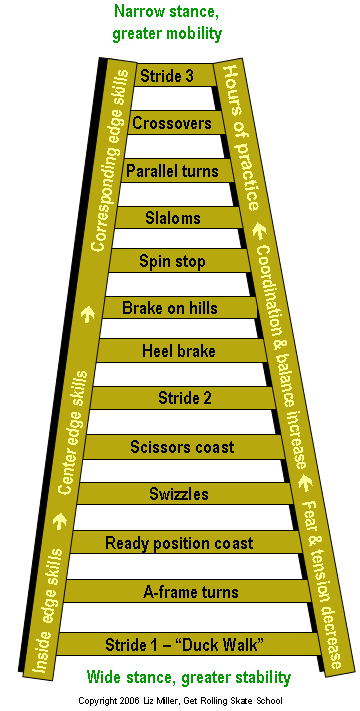Inline
Mastery Ladder
By Liz Miller
Realistic expectations for conquering the basic moves
The typical beginning skater can learn safety practices and the basic
turn and forward stride within one lesson. Other skills take longer to
build, especially when a narrow stance and good balance are required
(for example, Scissors Coasting to effectively use
the heel brake).
Of course, many factors affect how fast each individual will progress,
including activity and
fitness levels, degree of fear, and hours
of practice time.
Find your current rung below
and take it from there! Click a rung to read
about the technique in articles from the Get Rolling Orbit
library.

How to use this chart
To sustain your early enthusiasm,
you need realistic expectations about how you are likely to progress
in learning the skills that make skating fun and safe. You should also
know that the body builds sport-specific balance and coordination
little by little. This ladder represents the skill-mastery sequence I
have witnessed and cultivated in over a dozen years of teaching beginning
skaters. To properly master inline skating, each
rung is a pre-requisite for the next above. So...
- Start from the bottom. This is
typically is where young children and non-active beginning adults start
the climb. That said, beginners with an athletic background may master
all the rungs below the critical scissors
coast on their own or in a one-hour lesson.
- Tip your head and read
each side of the ladder to see what influences learning.
The left side shows a broad skill category that corresponds to the
comfort level of skaters as they learn to use their wheel edges. However,
for certain skills, edging may be superseded by practice time or coordination.
These influences are shown on the right side of the ladder.
- Sign up for appropriate instruction, regardless of
current mastery level. Most skaters need coaching
to learn the corresponding edge skills in the upper rungs. Without
instruction, they may never even realize these skills exist, much less
learn the joy of doing them.
The higher you climb the ladder, the more practice time you will spend.
The good news is that once you've mastered one rung, you rarely ever
have to think about it or the ones below it again because the skill has
become part of your physical foundation of capabilities, available for
any related activity. Meanwhile, you can and should practice
non-rolling stances and building drills to
develop muscle memory for inline skills that are several rungs above
your current capabilities.
A qualified
instructor can really help speed your learning curve. For safety's sake,
a beginner lesson will always focus on delivering the inline basics: Stride
1, A-Frame
turn and heel brake use.
Other instructors may disagree with my perspective of inline mastery
sequence, but we all agree that there are first-day skaters who will
not master braking right away. A good instructor will show you how to
work on the individual braking components in an achievable sequence:
ready position coast, scissors coast and finally, braking itself.
I hope my chart motivates
you to be patient as you continue climbing the inline mastery
ladder, rung by rung.
|



Other August 2006 Stories
 Technique: Scissors
Coast - Proper respect for the one building skill that every skater
needs the most and then takes for granted forever after. Technique: Scissors
Coast - Proper respect for the one building skill that every skater
needs the most and then takes for granted forever after.
 Treat
Your Feet - Tips to help you treat tired or crampy feet and lower
legs after a long day on wheels, plus advice for pain prevention. Treat
Your Feet - Tips to help you treat tired or crampy feet and lower
legs after a long day on wheels, plus advice for pain prevention.
 Skating
with Nordic Poles - Triathlete Joshua Delucca Colon describes
his journey learning a new way to cross train for endurance events. Skating
with Nordic Poles - Triathlete Joshua Delucca Colon describes
his journey learning a new way to cross train for endurance events.
 Growing
Young Before Her Time - Brigitte plans to celebrate her 50th birthday
at the local skate park, doing what she loves best, hammering the half
pipes. Growing
Young Before Her Time - Brigitte plans to celebrate her 50th birthday
at the local skate park, doing what she loves best, hammering the half
pipes.
 Point
Isabel Trail in Richmond, CA - Tracing the San Francisco Bay
shoreline, this bike trail offers views of the Golden Gate Bridge with whirling pelicans and seagulls overhead. Point
Isabel Trail in Richmond, CA - Tracing the San Francisco Bay
shoreline, this bike trail offers views of the Golden Gate Bridge with whirling pelicans and seagulls overhead.
 Leader
in Learning - Get Rolling.com earns an award of excellence; college
text book features Liz Miller’s Inline Skating chapter among
41 others. Leader
in Learning - Get Rolling.com earns an award of excellence; college
text book features Liz Miller’s Inline Skating chapter among
41 others.
 Review: eZeefit
Ankle booties may just be exactly the accessory you need for your
favorite human-powered sports. Review: eZeefit
Ankle booties may just be exactly the accessory you need for your
favorite human-powered sports.
 Skater
Crossing - Online destinations where skaters congregate and find
information. Skater
Crossing - Online destinations where skaters congregate and find
information.
 Mini
Survey: Non-reversing
Skate Wheels - Maybe they aren’t so crazy after all! Mini
Survey: Non-reversing
Skate Wheels - Maybe they aren’t so crazy after all!
Related Links
All About Momentum
Beginner Checklist
Intermediate Checklist
How many lessons? (chart)
Top 10 Learning Opportunities
(in recommended order)
2. Local instructor
3. Camp Rollerblade
4. Learn-to-Skate Tour
5. Group skating
6. Zephyr Skating Adventure
7. Skating event
8. Marathon Training
9. Half
or full marathons
10. Speedskating
camp
|